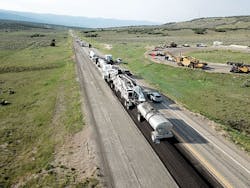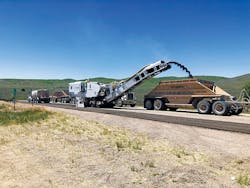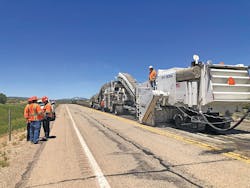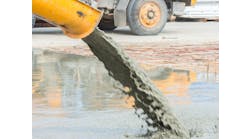A look at a 12.9-mile cold in-place recycling job along “National Park Highway” in Utah
By: Zach Girsberger
This paving season, crews were able to complete a successful project on U.S. 89, from Fairview, Utah to the Utah County line.
In 2020 the Utah Department of Transportation (UDOT) identified a 12.9-mile section of U.S. 89 north of Fairview, Utah as a viable cost-effective candidate for cold in-place recycling (CIR). The Fairview to Utah County line project was bid on January 26, 2021.
U.S. Route 89 is one the west’s most scenic highways. Reaching from Mexico to Canada, it’s known as the “National Park Highway.” With over 1,600 miles of a mostly two-lane paved highway, U.S. 89 passes through five states, numerous cities and towns, and is the gateway to seven national parks—including the Grand Canyon, Yellowstone, and Glacier—as well as 14 national monuments. Over the past three years, UDOT has conducted three CIR projects on U.S. 89—one each year from 2019 to 2021—totaling nearly 24 miles of placement.
Almost in the center of Utah and midway through the 1,600 miles is Fairview, a rural farming community, nestled in a valley surrounded by the San Pitch and Cedar Hills mountains on the west and Manti-La Sal National Forest on the east. In 1859, Brigham Young directed Mormon settlers to establish communities in the Sanpete Valley. Ninety-five miles south of Salt Lake City and 24 miles north of Ephraim (home of Snow College), Fairview is the largest town on the northeast end of the valley and home of Utah Gov. Spencer Cox. Constructed in 1888 and dominating the south end of the valley, the Manti Temple can be seen for miles.
A few miles north of Fairview is the remnants of the town of Thistle. In 1983, a landslide damned the Spanish Fork River and flooded the town, creating a ghost town. This event is the largest most costly natural disaster in Utah’s history. The railroad and U.S. 89 were closed for eight months while being rerouted to the east of the slide. A tunnel was constructed for the railroad.
General contractor Hales Sand & Gravel—a DBA company of Staker Parson companies—received the notice to proceed on Feb. 22, 2021. Knowing that temperatures were so critical on this project, Hales chose to begin the project on June 12, and completed the project Sept. 17, 2021. Along with the CIR process, UDOT identified a 2-in. SMA overlay.
Coughlin Company was the main subcontractor providing the CIR process. The CIR process was targeted for 7.75 miles of the total project. UDOT Region 4, with headquarters in Richfield, Utah, had past experiences with several CIR projects—including the U.S. 191 Indian Canyon, winner of the R&B/ARRA recycling project of the year award in 2019. Therefore, the team decided to use this method once again.
The CIR for this project was developed by Idaho Asphalt and used Peak Asphalt’s PASS-R emulsion with a targeted emulsion content of 3.0%. This mix used a total of 3% lime slurry (33% solids) using lime provided from the Graymont-Cricket Mountain Plant. Emulsion and lime were introduced to the mix utilizing the Roadtec RT-500 Mixing Trailer. The mix also incorporated 0.5% cement by weight from Ash Grove – Leamington. The cement powder was integrated into the mix during the milling operation by being spread up to 500 ft ahead of the mill and then processed with the milled RAP using a Roadtec RX-900 mill. This combination of materials led to a compactible mix, and with the integration of cement powder the team saw a rapid gain in strength. During testing for release to traffic, Landmark Testing & Engineering was regularly able to achieve the minimum 35 in.-lb of torque within two hours of finish rolling and often achieved 50 to 60 in.-lb by day’s end.
Prior to processing the cold in-place recycle, Coughlin Company was tasked to remove the upper 1.5-in. of the existing asphalt which primarily consisted of chip and crack seal. This material was accepted by Sanpete County as a product they could use as patching or shouldering material. Coughlin Company began removal of this layer a few hours ahead of the CIR process in order to facilitate a smooth ride for the public during construction operations. Each day, Coughlin processed CIR up to the exposed underlayer. This led to a challenge on the fourth production day when the mill hit the north end of the project, limiting production to only 1.45 miles. Having the forward mills flip around and having the CIR train continue would have forced traffic to change lanes in the middle of the project, which was permitted by UDOT with the appropriate traffic control implemented. Due to the logistics of the flip, it was decided to proceed with a shorter production day. Most of the crew did not argue with wrapping up early on a Friday.
The decision to use CIR was benefited by an unseasonably warm heatwave to begin the project. Ambient temperatures surged to highs of 98°F during the week of June 14, which led to internal windrow temperatures as high as 116°F during placement. The compaction of the mix benefited greatly from such high temperatures, with compaction averaging nearly 95% during these processes. The product also benefited from roller operators that were able to catch on to the differences between CIR and HMA. The project began with three operators typically performing three passes on the first Cat CB15 as breakdown, three passes on the CW34 as an intermediate roller, and varying between three to five static passes on the Cat CB15 roller used to finish. During the first week of production, no supplemental rolling was required to achieve the minimum 92% average established by UDOT.
Weather did not continue to work in favor of the project the next week, and only three days of production were accomplished due to rain in the area. Cloud cover that week was as high as 100% at times with temperatures at 10 a.m. averaging 20° cooler than the week prior and daily highs about 10° cooler. The project added a fourth roller—a Cat CCS9—during the second week of production when temperatures dipped to their typical highs, reducing the passes of the second CB15 from three to four and performing two passes on its own. On the sixth day of production, the first final density results below 92% were recorded. Those locations were able to be sufficiently rolled the next day, but similar issues presented themselves on the seventh day of production. These areas were not able to be supplementally rolled until two weeks after placement due to the pace of production—yet the material was able to gain 1.3% compaction during processes that much later. Average compaction from that day increased from 90.8% to 92.1% without having the mat break over and lose compaction due to breaking up of the aggregate structure. Supplemental rolling processes did not begin until the asphalt temperature achieved 90°F and peaked at 102°F.
During the construction process, Hales and Coughlin staged at MP 289, roughly at the midpoint of the project. The staging area made a convenient location for emulsion and Portland cement transfers. During the CIR process, Landmark Testing & Engineering also staged their QC lab here so samples were no more than 7 miles away from lab. This was especially beneficial since the Quality Assurance lab for UDOT was based in Price, Utah—a little more than an hour away from the project.
The project had two setbacks of note, one of which led to reprocessing and the other a change in procedures. On the first day of production, most of the paving crew was introduced to CIR for the first time. On-site training and processes were discussed, but a few standard operating procedures for HMA, such as heating the screed and using automatic leveling, led to slowdowns and a variable mat thickness. Only 0.47 miles were processed this way when the issues were caught and the decision to reprocess the material was made. The other setback was more of a cosmetic issue. Specification dictated that a fog seal was to be placed on the CIR layer after production. Due to the unusually high temperatures in the area, the fog seal the next day became pliable and stuck to the tires of heavier traffic during lane closures. This sticking led to traffic peeling away the upper layer in small patches. The issue was presented to Resident Engineer Brent Hadfield, who supported the decision to delay fog seal until later in the project but prior to the overlay of SMA. This decision was contingent upon the material staying bound and not unraveling, and proved to be a prudent call. During the rest of production, only one successfully compacted section at the joint of a two-day production pulled apart. The patch required for this was less than 5 sq ft in total.
As CIR is a newer process to many UDOT employees, the project offered a group of newer technicians and inspectors a chance to learn from several other UDOT employees who came to demonstrate and teach based on their experiences with the material. It also allowed key UDOT personnel to stress areas of concern from previous projects. Two noted points of stress included the ability of the pickup machine to process the full depth of material. Initially the MTV struggled to leave less than 3/4 in. of material and was swapped for a more powerful version. The other point of stress was the condition of the joints prior to placement. The MTV is unable to reach the final few inches of each joint, leaving the potential for poor compaction and binding between lanes. Previous methods used involved manually shoveling the joint or using a leaf blower to clear the joint. These methods proved ineffective on this project, and the paving crew from Hales implemented a creative solution—using the backhoe on the project to clear the joint by riding in between the joint and the windrow. This provided the additional benefit of keeping the backhoe near the MTV and train in case it was needed.
Following the cold in-place recycle process, the Hales Sand & Gravel paving crew started paving. They paved the first 5 miles that were designed for a 0.5-in. lane level, followed by a 1.5-in. SMA overlay. After completing the first 5 miles of lane-leveling, Hales’ crew installed a 2-in. SMA overlay on the remaining 7 miles of road. Hales achieved 45% of the possible compaction and gradation bonus, plus 76% of the potential smoothness bonus on this project.
About The Author: Girsberger is laboratory manager for Landmark Testing & Engineering.



